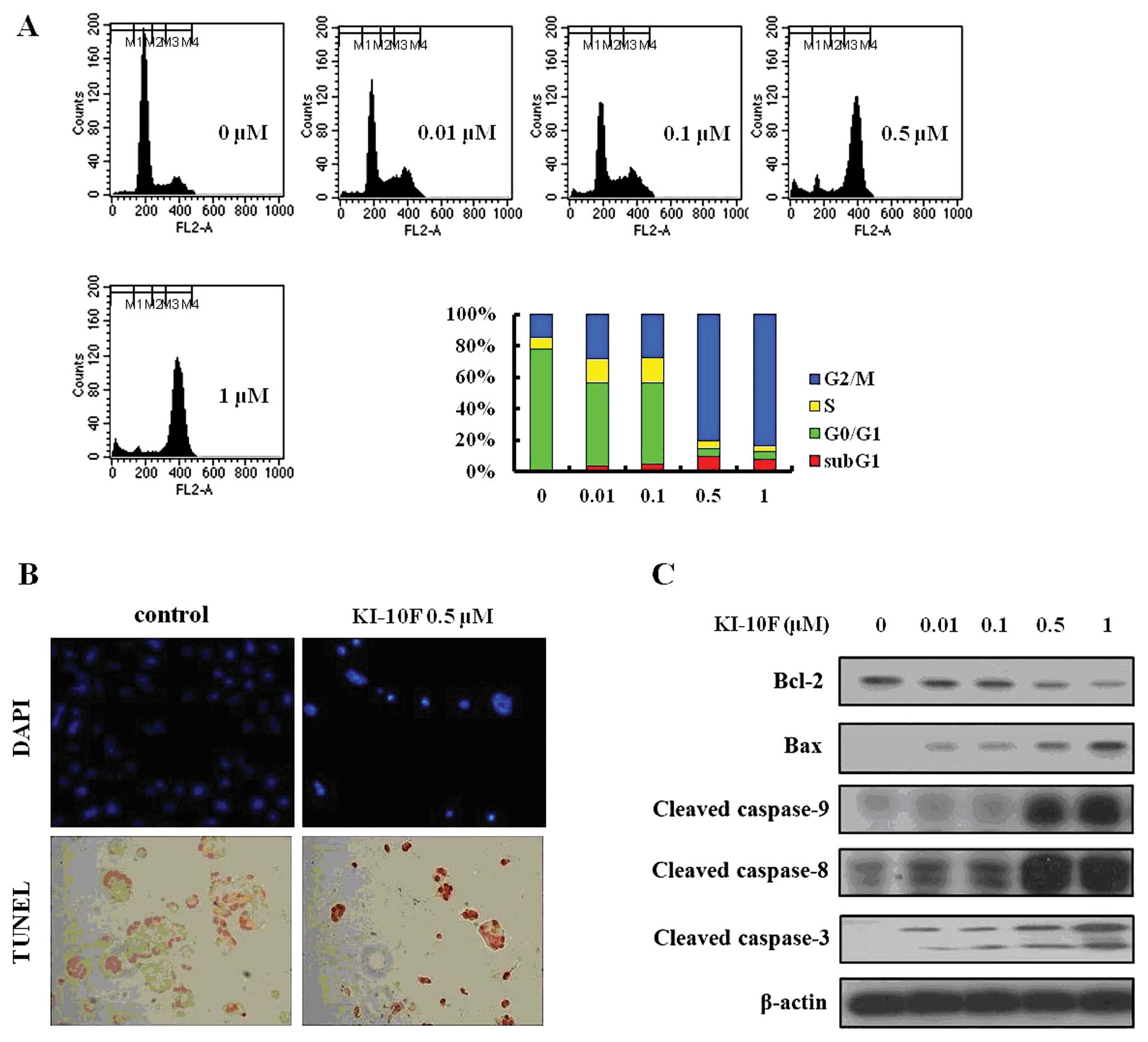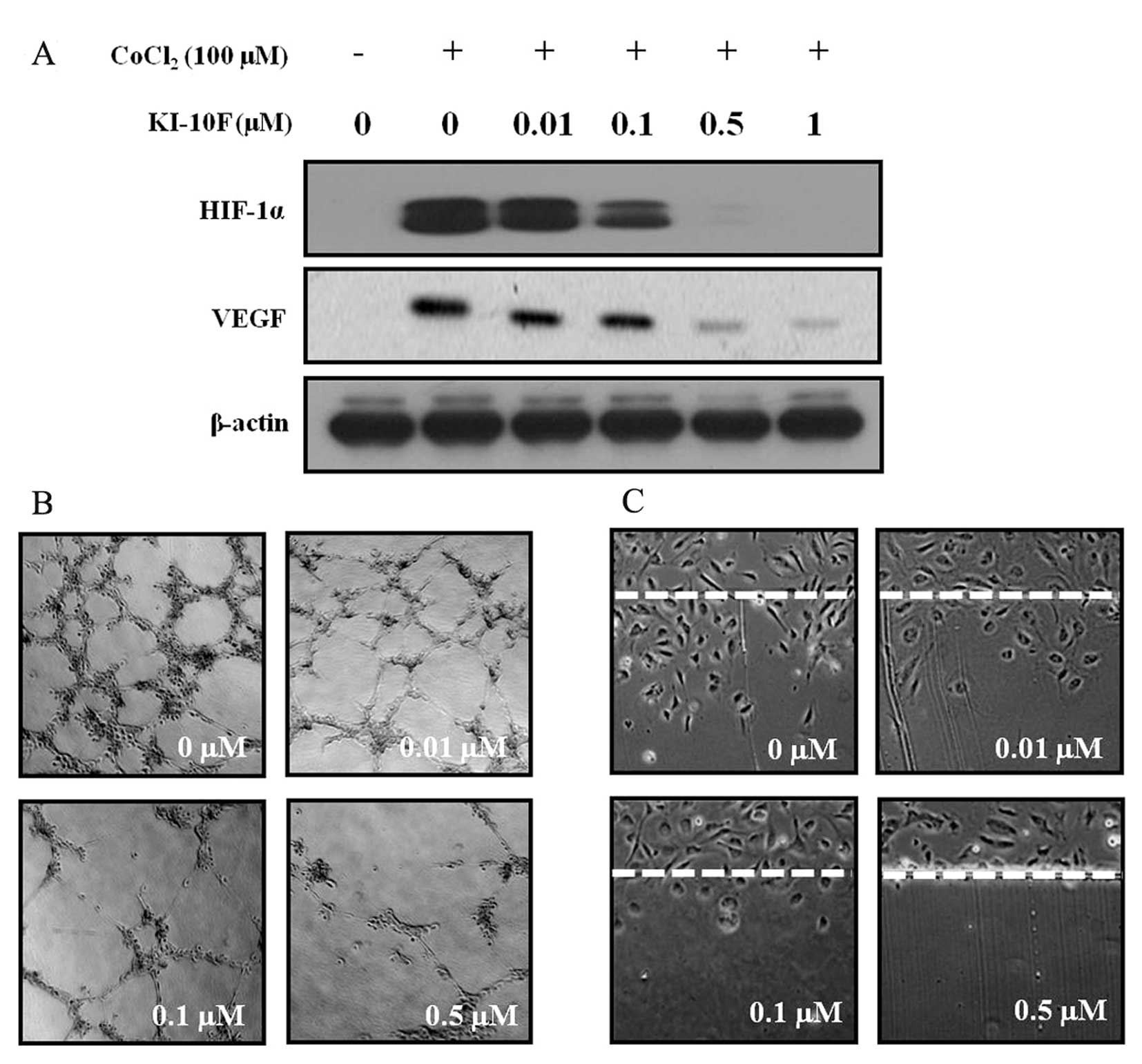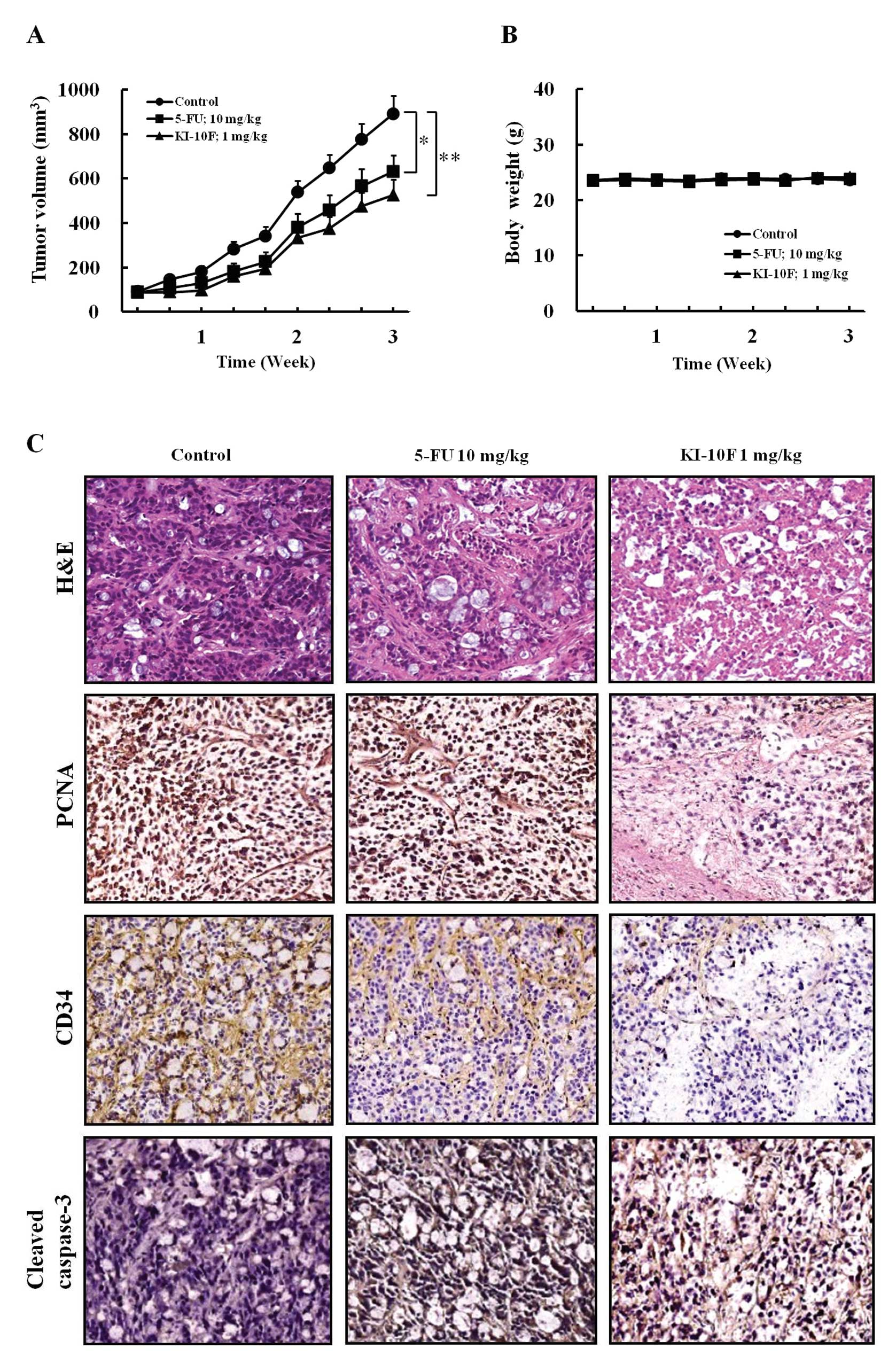|
1.
|
Shen W, Wang CY, Wang XH and Fu ZX:
Oncolytic adenovirus mediated Survivin knockdown by RNA
interference suppresses human colorectal carcinoma growth in vitro
and in vivo. J Exp Clin Cancer Res. 28:812009. View Article : Google Scholar : PubMed/NCBI
|
|
2.
|
Potter JD: Colorectal cancer: molecules
and populations. J Natl Cancer Inst. 91:916–932. 1999. View Article : Google Scholar : PubMed/NCBI
|
|
3.
|
Oh BY, Lee RA and Kim KH: siRNA targeting
Livin decreases tumor in a xenograft model for colon cancer. World
J Gastroenterol. 17:2563–2571. 2011. View Article : Google Scholar : PubMed/NCBI
|
|
4.
|
Zhang N, Yin Y, Xu SJ and Chen WS:
5-Fluorouracil: mechanisms of resistance and reversal strategies.
Molecules. 13:1551–1569. 2008. View Article : Google Scholar : PubMed/NCBI
|
|
5.
|
Pullarkat ST, Stoehlmacher J, Ghaderi V,
Xiong YP, Ingles SA, Sherrod A, Warren R, Tsao-Wei D, Groshen S and
Lenz HJ: Thymidylate synthase gene polymorphism determines response
and toxicity of 5-FU chemotherapy. Pharmacogenomics J. 1:65–70.
2001. View Article : Google Scholar : PubMed/NCBI
|
|
6.
|
Manfredini S, Bazzanini R, Baraldi PG,
Bonora M, Marangoni M, Simoni D, Pani A, Scintu F, Pinna E and
Pisano L: Pyrazole-related nucleosides. 4. Synthesis and antitumor
activity of some 1-tetrahydropyranyl-4-substituted pyrazoles.
Anticancer Drug Des. 11:193–204. 1996.PubMed/NCBI
|
|
7.
|
Park HJ, Lee K, Park SJ, Ahn B, Lee JC,
Cho H and Lee KI: Identification of antitumor activity of pyrazole
oxime ethers. Bioorg Med Chem Lett. 15:3307–3312. 2005. View Article : Google Scholar : PubMed/NCBI
|
|
8.
|
Lv PC, Li HQ, Sun J, Zhou Y and Zhu HL:
Synthesis and biological evaluation of pyrazole derivatives
containing thiourea skeleton as anticancer agents. Bioorg Med Chem.
18:4606–4614. 2010. View Article : Google Scholar : PubMed/NCBI
|
|
9.
|
Bandgar BP, Totre JV, Gawande SS,
Khobragade CN, Warangkar SC and Kadam PD: Synthesis of novel
3,5-diaryl pyrazole derivatives using combinatorial chemistry as
inhibitors of tyrosinase as well as potent anticancer,
anti-inflammatory agents. Bioorg Med Chem. 18:6149–6155. 2010.
View Article : Google Scholar
|
|
10.
|
Christodoulou MS, Liekens S, Kasiotis KM
and Haroutounian SA: Novel pyrazole derivatives: synthesis and
evaluation of anti-angiogenic activity. Bioorg Med Chem.
18:4338–4350. 2010. View Article : Google Scholar : PubMed/NCBI
|
|
11.
|
Fan C, Su H, Zhao J, Zhao B, Zhang S and
Miao J: A novel copper complex of salicylaldehyde pyrazole
hydrazone induces apoptosis through up-regulating integrin beta4 in
H322 lung carcinoma cells. Eur J Med Chem. 45:1438–1446. 2010.
View Article : Google Scholar : PubMed/NCBI
|
|
12.
|
Calhelha RC, Ferreira IC, Peixoto D, Abreu
RM, Vale-Silva LA, Pinto E, Lima RT, Alvelos MI, Vasconcelos MH and
Queiroz MJ: Aminodi(hetero)arylamines in the thieno[3,2-b] pyridine
series: synthesis, effects in human tumor cells growth, cell cycle
analysis, apoptosis and evaluation of toxicity using non-tumor
cells. Molecules. 17:3834–3843. 2010.
|
|
13.
|
Pracharova J, Zerzankova L, Stepankova J,
Novakova O, Farrer NJ, Sadler PJ, Brabec V and Kasparkova J:
Interactions of DNA with a new platinum(IV) azide dipyridine
complex activated by UVA and visible light: relationship to
toxicity in tumor cells. Chem Res Toxicol. 25:1099–1111. 2010.
View Article : Google Scholar : PubMed/NCBI
|
|
14.
|
Weidner N, Semple JP, Welch WR and Folkman
J: Tumor angiogenesis and metastasis - correlation in invasive
breast carcinoma. N Engl J Med. 324:1–8. 1991. View Article : Google Scholar : PubMed/NCBI
|
|
15.
|
Cristi E, Perrone G, Toscano G, Verzi A,
Nori S, Santini D, Tonini G, Vetrani A, Fabiano A and Rabitti C:
Tumour proliferation, angiogenesis, and ploidy status in human
colon cancer. J Clin Pathol. 58:1170–1174. 2005. View Article : Google Scholar : PubMed/NCBI
|
|
16.
|
Chen JM, Li WH, Wang JD, Feng YD, Wu JH
and Gong JP: Cell balance between apoptosis and proliferation in
colon cancer and its correlation with prognosis. Ai Zheng.
24:554–558. 2005.(In Chinese).
|
|
17.
|
Esposito E and Cuzzocrea S: New
therapeutic strategy for Parkinson’s and Alzheimer’s disease. Curr
Med Chem. 17:2764–2774. 2010.
|
|
18.
|
El-Deeb IM and Lee SH: Design and
synthesis of new potent anticancer pyrazoles with high FLT3 kinase
inhibitory selectivity. Bioorg Med Chem. 18:3961–3973. 2010.
View Article : Google Scholar : PubMed/NCBI
|
|
19.
|
Schmitz I, Kirchhoff S and Krammer PH:
Regulation of death receptor-mediated apoptosis pathways. Int J
Biochem Cell Biol. 32:1123–1136. 2000. View Article : Google Scholar : PubMed/NCBI
|
|
20.
|
Igney FH and Krammer PH: Death and
anti-death: tumour resistance to apoptosis. Nat Rev Cancer.
2:277–288. 2002. View
Article : Google Scholar : PubMed/NCBI
|
|
21.
|
Soengas MS, Capodieci P, Polsky D, Mora J,
Esteller M, Opitz-Araya X, McCombie R, Herman JG, Gerald WL and
Lazebnik YA: Inactivation of the apoptosis effector Apaf-1 in
malignant melanoma. Nature. 409:207–211. 2001. View Article : Google Scholar : PubMed/NCBI
|
|
22.
|
Nagane M, Levitzki A, Gazit A, Cavenee WK
and Huang HJ: Drug resistance of human glioblastoma cells conferred
by a tumor-specific mutant epidermal growth factor receptor through
modulation of Bcl-XL and caspase-3-like proteases. Proc Natl Acad
Sci USA. 95:5724–5729. 1998. View Article : Google Scholar
|
|
23.
|
Pitti RM, Marsters SA, Lawrence DA, Roy M,
Kischkel FC, Dowd P, Huang A, Donahue CJ, Sherwood SW and Baldwin
DT: Genomic amplification of a decoy receptor for Fas ligand in
lung and colon cancer. Nature. 396:699–703. 1998. View Article : Google Scholar : PubMed/NCBI
|
|
24.
|
Xu X, Zhang Y, Qu D, Jiang T and Li S:
Osthole induces G2/M arrest and apoptosis in lung cancer A549 cells
by modulating PI3K/Akt pathway. J Exp Clin Cancer Res. 30:332011.
View Article : Google Scholar : PubMed/NCBI
|
|
25.
|
Yang CJ, Wang CS, Hung JY, Huang HW, Chia
YC, Wang PH, Weng CF and Huang MS: Pyrogallol induces G2-M arrest
in human lung cancer cells and inhibits tumor growth in an animal
model. Lung Cancer. 66:162–168. 2009. View Article : Google Scholar : PubMed/NCBI
|
|
26.
|
Carmeliet P, Dor Y, Herbert JM, Fukumura
D, Brusselmans K, Dewerchin M, Neeman M, Bono F, Abramovitch R and
Maxwell P: Role of HIF-1alpha in hypoxia-mediated apoptosis, cell
proliferation and tumour angiogenesis. Nature. 394:485–490. 1998.
View Article : Google Scholar : PubMed/NCBI
|
|
27.
|
Bolat F, Haberal N, Tunali N, Aslan E, Bal
N and Tuncer I: Expression of vascular endothelial growth factor
(VEGF), hypoxia inducible factor 1 alpha (HIF-1alpha), and
transforming growth factors beta1 (TGFbeta1) and beta3 (TGFbeta3)
in gestational trophoblastic disease. Pathol Res Pract. 206:19–23.
2010. View Article : Google Scholar
|
|
28.
|
Spano D and Zollo M: Tumor
microenvironment: a main actor in the metastasis process. Clin Exp
Metastasis. 29:381–395. 2012. View Article : Google Scholar : PubMed/NCBI
|
|
29.
|
Tao BB, Zhang CC, Liu SY and Zhu YC:
Involvement of HIF-1 in the migration-promoting effects of hydrogen
sulfide in vascular endothelial cells under normoxic conditions.
Sheng Li Xue Bao. 64:129–134. 2012.(In Chinese).
|
|
30.
|
Ergun S, Kilic N, Wurmbach JH,
Ebrahimnejad A, Fernando M, Sevinc S, Kilic E, Chalajour F, Fiedler
W and Lauke H: Endostatin inhibits angiogenesis by stabilization of
newly formed endothelial tubes. Angiogenesis. 4:193–206. 2001.
View Article : Google Scholar : PubMed/NCBI
|













